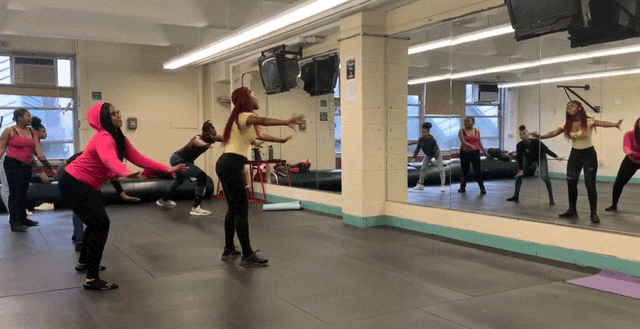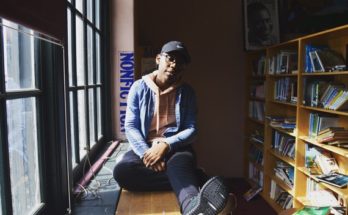
Photo Credit: Claire Fox
Inside a repurposed classroom squeezed between an industrial kitchen on one side and electrical work stations on the other, dance teacher Dale Qwaine Nathaniel Jr. shouted choreography commands to the beat of blaring music.
“Okay, let’s go from the top,” he directed his seven teenagers in the makeshift dance studio in late February. “In your spots.”
Standing at 6-feet, 5-inches tall, he commanded attention in the room, towering above his career and technical high school students. As the rehearsal time progressed, however, the William E. Grady alum disappeared among the dancers, who stomped their feet, twisted their hips and bumped along to Afro-pop playing from a speaker in the corner of the room.
In front of a mirrored wall, the female students practiced the dance they would be performing later in the week at the school’s Black History Month closing ceremony. To the song “Selense,” by Nigerian pop singer Yemi Alade, the girls spun and kicked their right legs high into the air in sync, before breaking off into pairs to showcase more individual talent. Performing alongside Nathaniel, freshman Jae’la Gibson jumped from her back on the floor up to her feet and into a split. When the music stopped, the students groaned.
Once the school bell rang for the end of first period, the dancers left Nathaniel’s studio out of breath and laughing. From there they headed for their more typical classes in automotive technology, nursing, construction, culinary arts and information technology.
On her way out the door to a class on nursing, Jae’la was one of the last to leave the studio. “I’d stay longer if I could,” she said. “I like it a lot.”
This was weeks before Grady and all public schools in New York City closed their doors and moved to virtual instruction in response to COVID-19. Nathaniel continues to teach classes remotely to students, showing off his moves through videos, but he can’t wait until he is back in the classroom again. The in-person experience was what propelled his popularity at the school.
In a high school best known for its industry training programs, Nathaniel’s dance class has become a surprise favorite in less than one year—so much so that students are known to skip their lunch periods to join in.
Nathaniel was hired this school year as a part-time dance instructor at his alma mater in Brighton Beach, Brooklyn, in order to give students a new arts class. The integration of dance classes is part of Grady’s effort to enhance student experience by going beyond minimum arts requirements mandated by the city’s Department of Education.
Arts had always been an afterthought at Grady, as it has been at many of the 130 Career and Technical Education (CTE) schools in New York City, where the goal is to prepare students with work-based knowledge and skills. With the largest number of CTE programs in the country, the city’s vocational programs are organized into 16 career clusters, ranging from engineering to hospitality to architecture and construction, and work to feed into the “public talent pipeline,” as overseen by a state advisory council.
Apart from the schools devoted to technical arts training, most CTE schools lack opportunities in arts education, due to the heavy course loads they require. Out of the 44 credits high school students need to graduate, seven must be electives. Students at Grady already exceed this city requirement, since CTE programs end up taking up 10 to 12 elective credits, leaving little room for anything else.
For this reason, along with difficulty in financially sustaining a full-time arts teacher, Grady lacked a choice in electives and fulfilled the bare minimum of providing two arts credits per student. Whereas other schools may have electives in music and visual arts, Grady offered arts-themed classes taught by existing history and English teachers as a way to meet the requirement.
“We just have nowhere to put it is really the bottom line,” said the principal, Tarah Montalbano. “I do feel that it’s a missing piece here.”
From performing at Grady’s Black History Month opening and closing celebrations to creating light hearted TikTok dance videos with their teacher as warmups, students in Nathaniel’s class adore what they learn in the studio. The class has become so popular that more students want to take it than there are available spots.
“Are you supposed to be in here right now?” Nathaniel asked one Friday afternoon as he spotted an extra student in the classroom, though he already knew the answer.
“No,” the boy replied under his breath as he sauntered back out into the hallway.
Nathaniel has come to realize that the class is in such high demand that students have lied about their lunch periods to him, so that they can get in on the dance lessons while they are supposed to be eating in the cafeteria.
Girls, in particular, in a student body population that is 73% male, gravitate toward the class. Sania Gilkes, a junior, is one of the students who enjoys coming to see Nathaniel twice a day, once during her scheduled gym class time and again during lunch. Sania used to sometimes come to school late, but that changed when she began dance class. If she arrives tardy in the morning, she can’t participate in the lunch session.
“Now that she has me first period, she knows that she has no choice but to get here on time,” Nathaniel said. “Even with a sad face, because it’s early in the morning, she’s here.”
Offering robust arts opportunities in schools has long been associated with positive outcomes for students. A study published in 2019 by Rice University’s Kinder Institute for Urban Research found that increasing art educational experiences reduces the proportion of students receiving disciplinary infractions, improves writing achievement and increases student empathy and emotional competency. However, reports from the federal government indicate the proportion of students receiving arts education has decreased dramatically over the last few decades, particularly for historically underserved communities.
As a class of 2011 graduate from Grady, Nathaniel is an anomaly. Being a CTE school, it usually does not attract students who want to pursue something in the arts professionally. Nathaniel was no exception. He was drawn to Grady for its computer technology program that partnered with CISCO at the time, and he spent most of his free time as a member, and later captain, of the football team. His only exposure to dance was in church.
Born in Trinidad, Nathaniel moved to the U.S. in the first grade and grew up deeply involved with his church community in Queens. Always found in some form of a leadership role, he often found himself orchestrating the dances in church.
The thought of making dance a career never crossed his mind until college. Nathaniel attended Queensborough Community College originally to become a math teacher, though it was mostly the teaching part he was drawn to.
“I’ve always taken that step to help and tutor people, so teaching was just another part of it for me,” he said.
When he took two classes one semester in ballet and modern dance simply for Physical Education credits, an instructor told him he was talented and should consider pursuing dance as a major. With what he refers to as a spiritual leap of faith, he decided to change his course of study. After two years in community college, he went on to receive a scholarship to Adelphi University to pursue a Bachelor of Fine Arts, where he studied ballet and contemporary dance.
“It’s a really weird jump going from football to math to dance, but all of the different backgrounds I’ve had helped me when dancing,” Nathaniel said. “I look at dance like math: when choreographing, you have a certain amount of people and you move them around in a certain way making sure they work together.”
His background in football is also visible. When he plans his choreography on paper, the sketches end up resembling a football play drawn out by a coach, the notes full of arrows, X’s and O’s.
Nathaniel is the director of Diverse Legends, a competitive dance company based in Queens, and also currently on track to receive his teaching credentials and master’s degree. Before this school year, he worked for two years as a dance teacher at Collaborative Arts Middle School in Springfield Gardens, Queens, working with a substitute and vendor license. When the school couldn’t keep him on for another year, Montalbano struck up a deal for him at Grady.
Back when Montalbano was a teacher at Grady, she had Nathaniel as a student in AP English. He recalls her pushing him to retake his standardized state test in English to get a better score—and so he did. The two kept in touch over the years that followed, particularly as Nathaniel decided he wanted to teach. Montalbano ended up attending his first choreography showcases in college. When the opportunity arose last summer, Montalbano offered him the dance instructor job as a part-time vendor as part of an idea she had been brewing.
From first to fifth periods, five days a week, Nathaniel leads classes for groups of up to 10 students at a time. Any students who are in gym class during those periods can opt to go to his dance class instead. By integrating it into existing physical education schedules and hiring a part-time instructor, Montalbano figured Grady could give students another arts offering this way.
“As an educator, I feel there has to be a place for kids to express themselves differently outside of English, history, math and social sciences all day,” said Montalbano. “It really has been a success.”
Despite the popularity of the class in the spring term, it wasn’t always that way. When the course first began last fall, the students didn’t fully buy into or understand what Nathaniel was having them do for the first month.
“They came in here thinking they were going to be doing Dubsmash, TikToks and things like that,” Nathaniel said, “but when I first came in I started demanding exercise and warmups, moving across the floor with traditional African dance movements.”
Returning to Grady, Nathaniel noticed that the culture in the school is largely Caribbean-based and African-American. Grady’s population being 51% black, Nathaniel decided to incorporate Caribbean and African dance styles into his teaching. Though he was never formally taught traditional African dance in school, he took it upon himself to learn it and feel close to his own culture.
In the last 15 minutes before the first period students had to leave for their vocational classes, Nathaniel switched up the music the students had been dancing the rehearsed sequences to. He told them he was adding a new song for them to learn and a mini choir of protests rang out among the girls.
“It’s always a fight at first,” Nathaniel said, “but afterwards they’re asking me to turn songs back on so they can do it all again.”
Within minutes the students had their eyes locked on their teacher’s movements and loosely followed along to the Beyoncé verse in a hiphop song playing through the speaker. Some of the girls looked confused as Nathaniel held his shoulders and arms tight in place by his sides and flexed, as his head bobbed and he stepped to the beat.
“You guys should know that I’m showing you Afrobeat moves,” he said. “In African tradition it’s not weird!”
For the remainder of class, the students learned the new sequences and ran through the moves several times each with the music paused and Nathaniel clapping the beat. Everyone laughed when he pointed out they were basically doing the “cabbage patch” dance move. Exhausted and sweaty, the students filtered out as the bell rang. Nathaniel sat down on a rolled up wrestling mat and drank from his water bottle, prepping for his next class to arrive soon.
“I enjoy myself and I see them enjoying themselves too,” Nathaniel said. “Coming back and seeing what I’m adding to the school makes it even bigger.”



